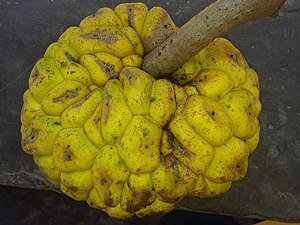Myrianthus arboreus
| Myrianthus arboreus | ||||||||||||
|---|---|---|---|---|---|---|---|---|---|---|---|---|

Fruit of Myrianthus arboreus |
||||||||||||
| Systematics | ||||||||||||
|
||||||||||||
| Scientific name | ||||||||||||
| Myrianthus arboreus | ||||||||||||
| P.Beauv. |
Myrianthus arboreus is a tree in the nettle family from Central and West Africa to Uganda , Tanzania and Sudan and Ethiopia .
Myrianthus holstii is similar .
description
As an evergreen tree, Myrianthus arboreus usually grows up to 10–20 meters high, and rarely even higher. The trunk diameter can be up to 1 meter. Air and stilt roots are often developed. The bark is relatively smooth and grayish.
The leaves are arranged in a spiral and hand-shaped with 5–7 leaflets . Individual leaflets are sometimes just sleek or fused with another at the base. The ribbed petiole, broadened at the base, is very long at 20–50 centimeters. The very long, sessile to short-stalked leaflets are up to 35–65 centimeters long, they are obovate, -eilanceolate to lanceolate. The middle leaflets are largest and the outer leaflets are decreasingly shorter. They are sawn to roughly toothed at the edge and pointed to pointed at the tip. On the pale green underside they are short whitish to brown or grayish and finely haired on the multi-veined , raised and feathery network nerve and in between whitish-cobweby, on top they are only slightly hairy. The stalk comprehensive, hairy stipules are sloping.
Myrianthus arboreus is dioecious, dioecious, with axillary inflorescences. The very small male flowers are in very dense, elongated cymes (glomerules) that are close to the inflorescence axes, upholstery on the outer twigs and branches, in multi-branched and branched and long-stalked inflorescences. The female inflorescences are dickgestielte, Multiflora and 3-3.5 centimeter head with early-sloping supporting and cover sheets under the head. The flowers are sitting, have the initially green then yellow female flowers a two- to three-piece, feinwärzliches in the upper part and -haariges perianth and are surrounded with spatula cover sheets and a top permanent, single-chamber ovary with tongue-shaped scar on a short style . The yellow to yellow-brown male flowers have three to four tepals and (two) three to four, short, sometimes overgrown stamens , they are surrounded by bracts.
Small, solitary and stone fruit-like, about 2 centimeters long fruits are formed which stand together in a roughly spherical and 8-15 centimeter large fruit association and are each encased by the fleshy, yellow to orange, four to hexagonal perianth ( false fruit ). The flattened and egg-shaped, woody and partly finely ribbed, about 1.3-1.7 centimeters long kernels ( endocarp ) are smooth and orange-beige.
The number of chromosomes is 2n = 28.
Taxonomy
It was first described in 1805 by Ambroise Marie François Joseph Palisot de Beauvois in Flore d'Oware et de Benin en Afrique 1:17.
use
The fruits are edible and sour and taste like pineapple. The young leaves are also used cooked. The seeds are also edible and are cooked.
literature
- A. Engler : Monographs of African Plant Families and Genera. Vol. 1: Moraceae (Excl. Ficus) , Engelmann, 1898, p. 37 ff, T. XVI, online at Digital Collections - at the Goethe University Frankfurt.
- K. Kubitzki , JG Rohwer , V. Bittrich: The Families and Genera of Vascular Plants. Vol. II: Flowering Plants Dicotyledons , Springer, 1993, ISBN 978-3-642-08141-5 (Reprint), p. 243 ff.
- G. de Ruiter: Revision of the Genera Myrianthus and Musanga (Moraceae). In: Bulletin du Jardin botanique National de Belgique / Bulletin van de Nationale Plantentuin van België. Vol. 46, no. 3/4, 1976, pp. 471-510, online (PDF; 4.8 MB), at Naturalis repository, accessed on October 7, 2019.
- Essences forestieres fruitieres et alimentaires. 1: Exemples d'Afrique orientale Étude FAO Forêts 44/1, FAO, 1984, ISBN 92-5-201385-7 , p. 69 ff.
- D. Prain : Flora of Tropical Africa. Vol. VI, Sect. 2, Reeve, 1917, p. 231 ff, online at biodiversitylibrary.org.
Web links
- Myrianthus arboreus at Useful Tropical Plants.
- Myrianthus arboreus at PROTA.
- Myrianthus arboreus . In: S. Dressler, M. Schmidt, G. Zizka (Eds.): African plants - A Photo Guide. Senckenberg, Frankfurt / Main 2014.
Individual evidence
- ↑ Myrianthus arboreus at KEW Science.
- ↑ online at biodiversitylibrary.org.